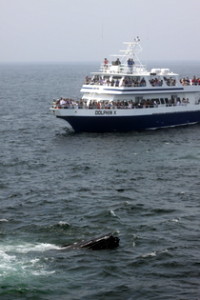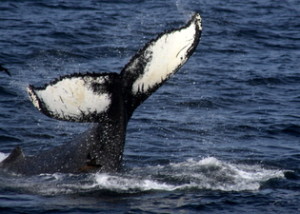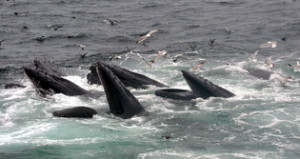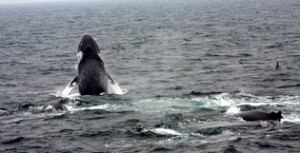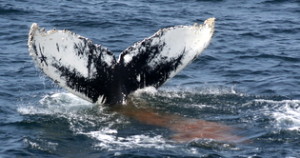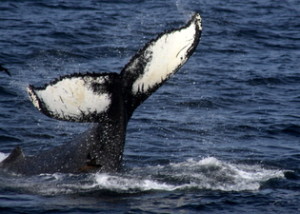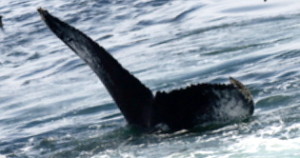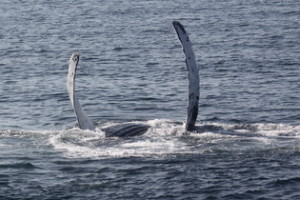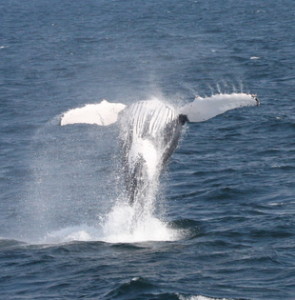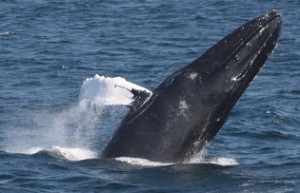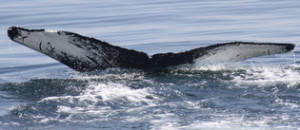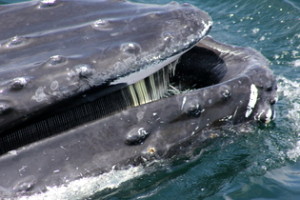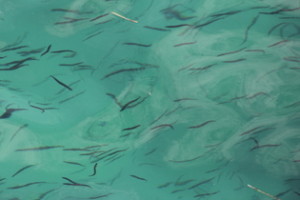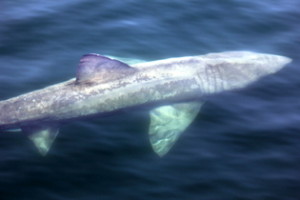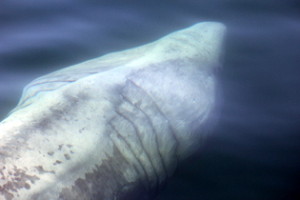July 2 to July 8
The clear skies and warm weather made July 2nd a perfect day to go out on the Dolphin Fleet. We made our way toward Peaked Hill, a prominent dune on the north-facing beach of Provincetown. A few miles north of the beach, we found 4 groups of feeding humpback whales. Trios and quartets of whales blew bubble clouds and bubble nets, coming up through clouds of baitfish with wide open mouths.
One very active individual intermittently interrupted the feeding with full and partial breaches, chin and tail breaching, lobtailing and flipper slapping!
Just as amazing as the whales were the huge flocks of birds that were going after the fish that the whales pushed up to the surface. One of our naturalists who specializes in bird counts estimated that there were as many as 2,500 sooty shearwaters in the area. We even saw them as soon as Long Point. Seeing these pelagic birds so close to land is rare, but they were clearly attracted to all of the food in the water.
July 3rd marked the launch of the newest addition to the Dolphin Fleet, the Dolphin X.
Our first trip brought us to a huge group of humpback composed of both old favorites and new flukes. Stub, Aerospace, Duckpin, Habenero, Eruption, Putter, Canopy and Peninsula were among the whales who were cooperatively bubble feeding and kick feeding right along side the boat.
The whales seemed to take a mid-day siesta as the early afternoon trips were characterized by long dives. We did, however, have a close approach from a humpback named Thalassa, a female born in 1985 to Salt, one of the most well- known humpbacks in the Gulf of Maine.
Thalassa
By evening, the whales had perked up and began to feed again. More and more humpbacks were seen stretched out across the tidal rip, feeding constantly.
Then, who did we see but Salt herself! Named for the bright white streak across her dorsal fin, Salt was the first humpback to be recognized on a consistent basis. She was first seen in 1975 and she has come back every year, sometimes with a calf in tow. Although research teams spotted Salt to the East of Cape Cod in previous weeks, this was the first day this year that Salt made an appearance for any Dolphin Fleet vessels!
In this group of feeding humpbacks there were also two mother and calf pairs. Wizard and Ganesh lunged through huge schools of fish, while their calves, still not ready to feed on solid food, rolled and played, slapping their flippers, breaching, and kicking their small flukes.
On July 4th the whales were even more spectacular than the fireworks we returned to on the evening’s trip! The day started out hazy and gray. We began our morning’s trip with two fin whales, who we recognized as Cusp and Sunspot. These two whales have been traveling together for the last few days — an unusually long time for a pair of fin whales! Sunspot is a female who has had calves in three consecutive calving seasons. This is quite a feat considering the most fin whales wait a year after having a calf before having another.
After a few good looks at the finners, we headed to the north where we found a huge pile of feeding humpbacks! Echo, Scrach, Habenero, Rocker, Duckpin and Dome were kick feeding and blowing bubble rings all around us.
We no longer had any need to point out where the whales were. Everywhere we looked there was a huge open mouth sticking up out of the water!
In the mid-afternoon the whales were spread out and seemed to have lost the stamina to continue feeding. Despite the huge schools of sand eels that we saw swimming around the boat, the whales seemed to have no interest, and instead bobbed lazily at the surface. Despite their low-key behavior, we had wonderful looks at Salt, as well as a few mother and calf pairs. Wizard’s calf, less than a year old, breached several times, while Ganesh’s calf stuck close by its mother.
By the end of the trip, the whales appeared to perk up. Touche, a female first seen in 1985 was rolling and flipper slapping, and finally headed to the east with one final fluke. The brown substance you see in the photo below is exactly what you think it is. After a morning full of feeding, what goes in must come out!
When we returned in the evening, we started our trip with Thalassa, Salt’s 1985 calf. Thalassa was causing plumes of white water to rise to the surface as she kicked and lobtailed. All of Salt’s calves have “salty” names, and Thalassa is the name of a sea goddess in Greek mythology.
Thalassa
We soon parted ways with Thalassa when we saw what was going on in the distance. From the birds and splashing, we knew that feeding had started afresh. When we arrived on the scene, we counted upwards of 30 whales chowing down, mouths open, full of fish. Passengers are often astonished that such large whales eat such small fish, but humpback whale throats are not much larger than a grapefruit. Furthermore, these little fish, being low on the food chain, are abundant and high in usable energy, making them an ideal food choice for the humpbacks.
Despite the previous evening’s feeding frenzy, the whales didn’t seem to have made a dent in the sand eels in the area. The next morning on July 5th, the water was so calm that you could see the baitfish swimming for miles around! This time, the whales weren’t ignoring it. There was a lot of feeding in the am with great looks at Salt with huge mouthfuls of these small schooling fish. Other identified humpbacks included Dome, Coal, Centipede, Etch-a-Sketch and Cantilever, the 2007 calf of Fulcrum.
The flat calm seas also made it easy to spot the heads of the gray and harbor seals which live in the area. In the morning, we spotted a tiny harbor seal as it came right up to the boat. Due to its small size, we suspected that it had just been weaned. Later in the day, a huge gray seal made an appearance with a huge bass in its mouth. It was eating it like an ear of corn with the fish wedged between its flippers!
On the evening trip, the whales had stopped feeding but were still extremely active. We were particularly excited to see Colt, a large male famous for his close boat approaches. Today, Colt seemed less interested in the boat and more interested in rolling on his back, flipper slapping. On such a huge humpback, those flippers can be up to 15 feet long!
To top off the evening, several of the boats found a large pod of Atlantic white-sided dolphins! These toothed whales are wide-ranging and are seen in Stellwagen Bank regularly, but unpredictably. One was even seen with a playful calf leaping at her side!
Morning trips on July 6th experienced more non-stop feeding. Dome was louder than ever–she seems to trumpet with every surfacing–and Epee, Fracture, Scrach, Tectonic, Echo, and Eruption all joined forces to create huge bubble clouds surrounding massive schools of fish. The whales were stretched out from the site of the old Peaked Hill Buoy out to the “triangle”, and area east of Stellwagen Bank.
In the afternoon, the wind from the southwest picked up, and all of a sudden the feeding stopped in favor of non-stop breaching. Old and young whales alike leaped out of the water, gracefully spinning before they fell with a crash. Wizard’s calf and Ganesh’s calf were particularly active, taking breaks to tail breach and flipper slap in between jumps!
It wasn’t just the young’uns that were at it today. Touche, seen on two previous days lobtailing, made the switch to full on breaches, nearly splashing the bow of the boat when she landed!
While we can’t really predict when feeding will occur, it is not too far of a stretch to say that fish locations are sometimes associated with the tide. We weren’t too surprised when, on July 7th, the morning trips had great looks at feeding once again.
New whales seen in the area this morning included Buckshot, Putter, Warrior, a female first seen in 1979, and Loon, not to be confused with the fin whale of the same name.
All around us, humpback whales were “dragging” meaning that they were swimming forward, actively trying to push the water out between their baleen plates while simultaneously trapping fish behind the bristles of the baleen. Looking closely, we can see the pile of fish caught in the whale’s lower jaw.
We could also see the fish swimming freely in the water before they were devoured! An sand eel might lay tens of thousands of eggs in a year, meaning that there is a huge source of food for these humpbacks when they return to their summer feeding grounds.
The humpbacks weren’t the only creatures feasting. Today, we had our first sighting of a basking shark for the summer. Despite their fearsome appearance, these huge fish are harmless. Like the right whale, they feed on nearly microscopic bits of plankton!
After a week of perfect weather, July 8th was the only dud. It drizzled rain all morning but we still managed to find some whales despite the low visibility. Reflection, a female first seen in 1982 was spotted heading north along the east side of Stellwagen Bank in the morning. Barb and Joy soon made appearances, making the best of this rainy day. These two humpbacks began to lobtail, and one of them even popped up right under the bow, swimming back and forth beneath the Dolphin X! At one point, one of them even spyhopped — a sign of a curious whale trying to lift its eyes above sea level!
Later in the day, Apostrophe was also sighted. Apostrophe and Scratch were also spotted. Both of these female humpbacks are nearly annual visitors to Stellwagen Bank, and have been seen for decades. Apostrophe was born in 1982 and Scratch was first seen in 1979!
Here’s where we went this week: After spending a few days off the beach, these humpbacks seem to be heading towards the eastern edge of Stellwagen. We’ll be curious to see where they end up next week, and whether the feeding frenzy continues!







